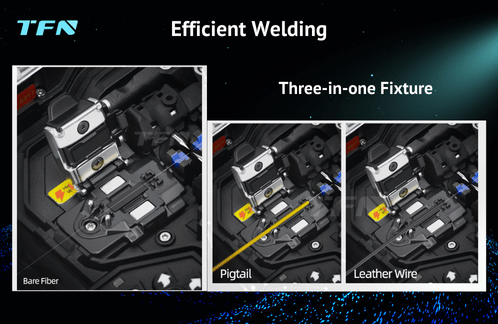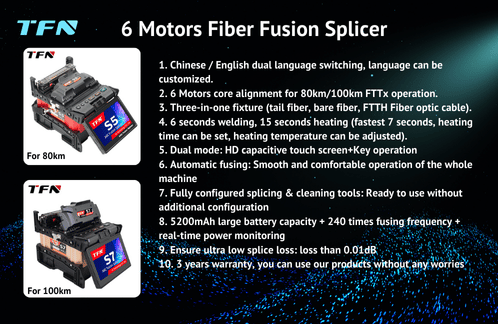How to improve the splicing efficiency when using a core-aligned fiber fusion splicer?
The core-aligned fiber fusion splicer is a high-precision fiber fusion splicing device. It can accurately identify the fiber type and automatically select the matching splicing mode through a precise six-motor alignment system, a specially designed optical lens and software algorithm. After the cores of the two optical fibers are aligned with high precision, a high-voltage arc is used to melt the fiber sections and fuse them into one fiber to achieve high-quality fiber splicing. This type of splicer is widely used in the field of optical communications, especially when the splicing quality requirements are high.
When using a core-aligned fiber fusion splicer, improving the splicing efficiency is a comprehensive process involving equipment preparation, operation process optimization, environmental control, maintenance and personnel skills improvement. The following is a detailed description of how to improve splicing efficiency:

1. Equipment preparation and selection
Choose a high-precision fusion splicer: Choose a fiber fusion splicer with a high-precision fiber core alignment system. This type of equipment can automatically align the fiber core with high precision, reduce human alignment errors, and improve the quality and efficiency of fusion. Ensure that the fusion splicer has windproof, dustproof, moisture-proof and other functions to adapt to various complex working environments.
Prepare materials and tools fully: Before fusion, prepare the required optical fiber, fiber stripping pliers, cutting knives, alcohol, cotton cloth, heat shrink tubing and other materials and tools. Check whether the power supply of the fusion splicer is sufficient to ensure that the equipment can work continuously and stably.
2. Operation process optimization
High-precision alignment: Use the high-precision optical camera of the fusion splicer to align the fiber core. During the alignment process, pay attention to adjusting the focal length and viewing angle of the fusion splicer to ensure that the fiber core image is clear and discernible. For multi-core optical fibers, the rotary motor and longitudinal translation motor of the fusion splicer can accurately align multiple fiber cores to reduce the difficulty and time of fusion.
Reasonable setting of welding parameters: According to the type and characteristics of the optical fiber, the parameters of the welding machine are reasonably set, including pre-discharge current, time, main discharge current, time, and fiber feeding amount. Through multiple tests and adjustments, find the appropriate combination of welding parameters to ensure a smooth welding process and low loss.
Fast welding and detection: Use the automatic mode of the welding machine for welding, reduce manual intervention, and increase the welding speed. After the welding is completed, use the automatic detection function of the welding machine to evaluate the quality of the welding point to ensure that the welding quality meets the requirements.
3. Environmental control
Keep the working environment clean: Clean the working area regularly to avoid dust and debris from contaminating the optical fiber and welding machine. When working in a dusty and humid environment, additional protective measures should be taken, such as using dust covers and dehumidifiers.
Control temperature and humidity: According to the use requirements of the welding machine, control the temperature and humidity of the working environment within an appropriate range. Avoid welding operations under extreme temperature or humidity conditions to avoid affecting the quality and efficiency of welding.
4. Maintenance and care
Clean the equipment regularly: Clean the electrodes, fixtures, mirrors, V-grooves and other parts of the fusion splicer regularly to remove dust and fiber fragments. Use a soft dry cloth or special cleaning agent for cleaning, and avoid using hard objects or highly corrosive cleaning agents to damage the equipment.
Replace the electrode in time: Check the wear of the electrode regularly and replace the electrode with severe wear in time. When replacing the electrode, follow the instructions in the operation manual to ensure that the electrode is installed correctly and in good contact.
5. Personnel skill improvement
Professional training: Provide professional training for operators to familiarize them with the operating procedures, parameter settings and maintenance methods of the fusion splicer. Improve the professional skills and proficiency of operators through a combination of theoretical learning and practical operation.
Experience accumulation: Operators continue to accumulate experience in actual work and master the fusion splicing skills and methods of different fiber types and characteristics. Encourage operators to share experiences and insights to create a good atmosphere of mutual help.
In short, improving the fusion efficiency of the core-aligned fiber fusion splicer requires equipment preparation, operation process optimization, environmental control, maintenance and care, and personnel skill improvement. By taking these measures, the welding loss and failure rate can be significantly reduced, the welding quality and efficiency can be improved, and a strong guarantee can be provided for the stable operation of the optical communication network.
Among the S series fiber fusion splicers currently launched by the TFN brand, S5 and S7 are core alignment models, suitable for 80km and 100km trunk line projects respectively. The equipment has fast splicing speed, rapid heating, windproof, dustproof and moisture-proof functions, and can adapt to various complex working environments. It is equipped with an intelligent UI user interface, easy to operate, and supports automatic splicing mode to ensure accurate fiber docking and help users complete fiber splicing tasks.

If you are interested in TFN's S5 and S7 fiber fusion splicers, please contact the TFN sales team:
Email: info@tfngj.com
WhatsApp: +86-18765219251
Facebook: https://www.facebook.com/tfnfate/
